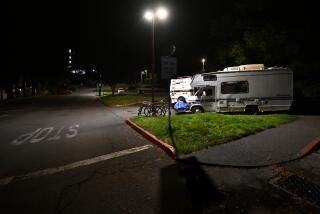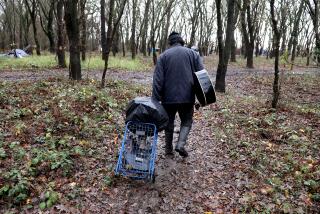Op-Ed: Should we set up New Deal-style work camps for the needy?
“They are sending out emergency calls for shoes, underwear, sleeping garments, household equipment, mattresses, springs and bedding,” a Los Angeles Times story reported from Southern California. Do-gooders were doing what they could to help the destitute. “They have no sanitation,” a volunteer said. “No running water. Before the storms this week, we had set into motion a campaign in their behalf.”
The above reads like an article about the homeless from this month’s California section. But the dispatch actually dates from 1938, and the needy were the most mythologized of Golden State refugees: the Okies. Some 16,000 had settled in Montebello and Bell Gardens, the Times wrote, and the “distress … [was] terribly acute.”
Dust Bowl migrants have been on my mind recently, mostly because I just finished “California and the Dust Bowl Migration” by Walter J. Stein, a 1973 book that’s one of the earliest academic surveys about how that momentous exodus changed the state. It’s a great, if dry, read, and the Canadian professor puts more blame on the New Deal for pushing Oklahomans from their farms than he should.
But the book offered me perspective. The most recent estimate of California’s homeless population, by the Department of Housing and Urban Development’s annual Point in Time Census, is 114,000. That number pales in comparison with the estimated 350,000 Okies who flooded California, mostly during the second half of the Great Depression. And, despite initial hiccups, we came out of it just fine.
Create a public-private-nonprofit partnership to set up homeless workers’ camps.
Stein’s tome also provides a way forward: workers’ camps. Yes, that sounds politically incorrect, somehow, but stay with me.
The Farm Security Administration (FSA) built about 15 such camps to house Okies who were getting booted out of the shantytowns known as Hoovervilles. The government-sponsored camps were refuges from hate, with running water and clean living quarters and an ordered way to find work. Most even printed monthly newsletters. They sprang up in the Imperial Valley and Sonoma, the Central Valley and near Indio. Only one remains in operation: the Sunset Labor Camp just outside Bakersfield, which served as the inspiration for the Rooseveltian eden that the Joads find in “The Grapes of Wrath.”
Now’s the time to bring them back, especially since Orange County officials plan to evict the hundreds of homeless along the biking trails of the Santa Ana River, within eyesight of the 57 and 5 freeways. Similar schemes are in the works across the state. Advocates are already warning that the homeless will have nowhere to go: There’s not nearly enough shelter space, and many are in no condition to reenter society, which means they will set up their tents in residential neighborhoods, whose inhabitants will just call the cops and offer no help.
This scenario mirrors what happened in the Great Depression. Townspeople and politicians alike initially protested the Okie enclaves because, according to Stein, the respectable class felt they “foisted upon them an unnecessary and dangerous concentration of migrants.”
The camps weren’t perfect: Stein criticizes government officials who ran the program for trying to teach the proudly individualistic Okies “to subordinate private goals to the welfare of the group.” And he mocks the liberals who tried to social-engineer social conservatism out of the Sooners. Stein describes how camp managers ridiculed the migrants’ evangelicalism as “productive of fanaticisms and irrationalities which can seriously disturb the general social equilibrium.”
But Stein nevertheless deems the experiment a success. “In the midst of the panic and prejudice that gripped the state, at the height of the anti-migrant campaign waged at the statehouse and in the press,” he concludes, “FSA provided islands at which stereotyped patterns of behavior were shaken.”
I hear the naysayers already. California doesn’t exactly have the best track record with camps for the marginalized, of course — Manzanar and Tule Lake. It was World War II’s industrial boom that ultimately gave the Okies jobs, not the government.
But city, county, and state officials have thrown hundreds of millions of dollars at the homeless issue for decades now, and it keeps growing. It’s time to think radical. Create a public-private-nonprofit partnership to set up homeless workers’ camps. Let funding come not from taxes but from companies that want to train a population that needs jobs. Have Sacramento monitor against exploitation. Allow these camps to give the homeless a sense of dignity and a place to heal their traumas, just like the FSA version gave the Okies.
And give day-to-day responsibilities to the saints who have chosen to help homeless people as a secular vocation, who know how to solve the problem — but have never had the resources to do so properly.
Those do-gooders who helped the Okies of Southeast Los Angeles in that 1938 Times piece? It was a local chapter of the California PTA. The group knew then what we should remember now: If there’s a Californian in need, help them, don’t shun them. Because they are us.
@gustavoArellano
Follow the Opinion section on Twitter @latimesopinion or Facebook
More to Read
A cure for the common opinion
Get thought-provoking perspectives with our weekly newsletter.
You may occasionally receive promotional content from the Los Angeles Times.







